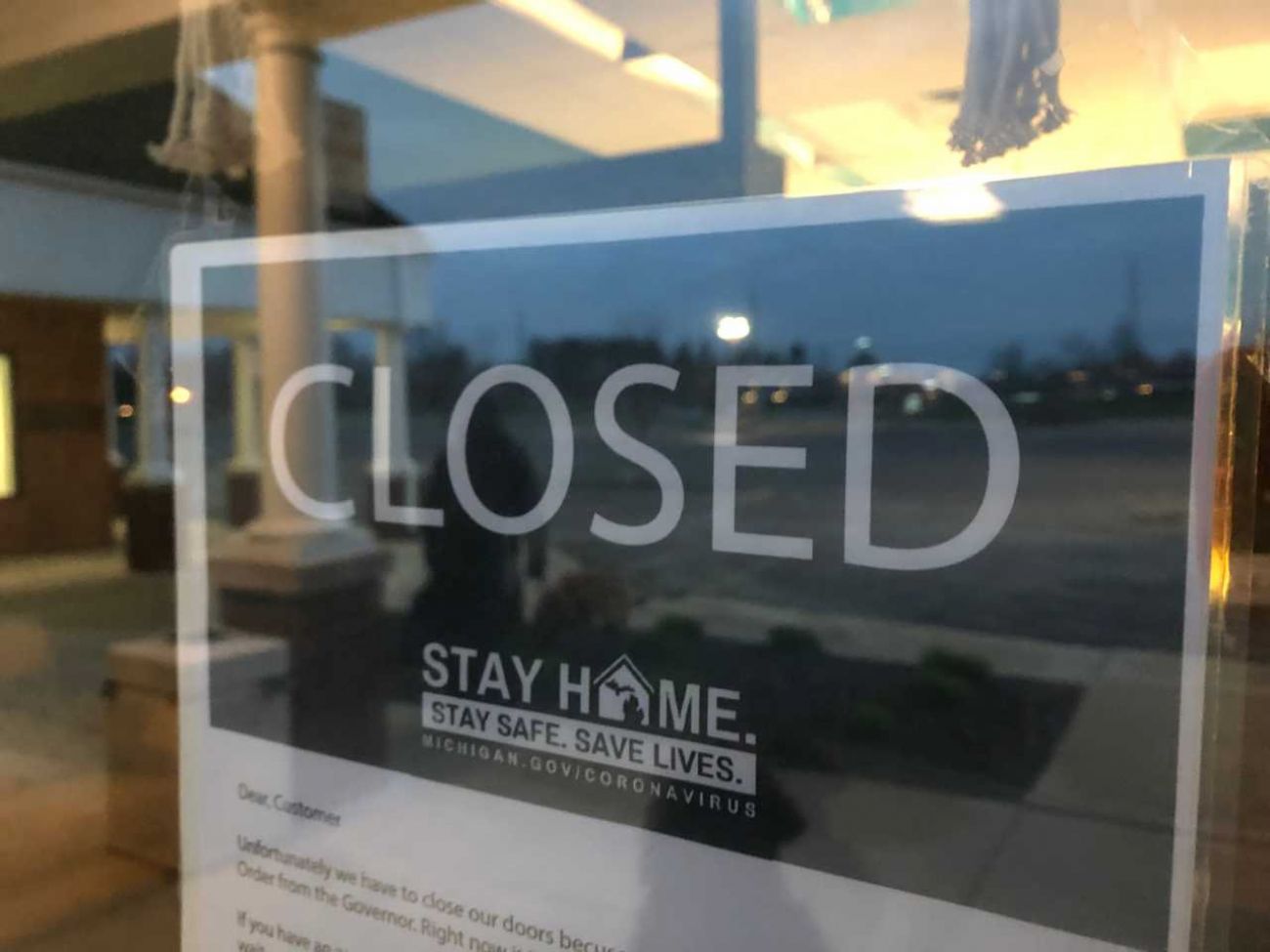Q&A with Brian Calley: 1 in 7 Michigan small businesses worry about survival


One in seven small businesses in Michigan may not survive the COVID-19 pandemic and related closure orders, their owners warn in a survey released this week.
“Michigan small businesses are truly struggling to survive,” said Brian Calley, president of the Small Business Association of Michigan.
The survey, conducted in late April of more than 1,300 Michigan small businesses, also found that 60 percent of businesses have had to lay off at least one employee.
Small businesses employ about half of all Michigan workers. Most of the survey respondents have fewer than 30 workers, Calley said.
The survey paints a picture of how even reopening comes with additional challenges, raising questions about how businesses will navigate the rest of the year.
From the survey:
- Nearly 45 percent of small businesses are closed.
- More than 50 percent of small businesses don’t have the ability for their employees to work from home.
- 72 percent of surveyed businesses have applied for the Paycheck Protection Program, and 43 percent have applied for other loans or advances.
- 56 percent of small businesses don’t believe they will be able to implement split shifts to limit exposure to the virus.
- 35 percent of small businesses would need additional physical space to meet social distancing guidelines.
- 44 percent of small businesses said they don’t qualify for classification as critical essential infrastructure.
Bridge Magazine’s Business Editor Paula Gardner spoke with Brian Calley, president of SBAM, about the survey results and efforts to improve the situation for small businesses. Here are excerpts.
- Michigan Gov. Whitmer extends coronavirus stay-at-home order to May 28
- Whitmer reopens Michigan from coronavirus in phases: What that means to you
- The latest: Michigan coronavirus map, curve, chart, updated COVID-19 news
What surprised you about the survey results showing 1 in 7 businesses didn’t have confidence about surviving?
That number really did jump out as troubling. I don’t want to say totally surprising. But 14 percent of businesses — who are not start-ups, but that would be mature enough to want to join a statewide association like ours — is a very high number.
Four percent felt they were already at the failure point. Another 10 percent were very uncertain they could survive. Entrepreneurs are typically very confident and positive, can-do type people. Because you have to be. You have to assume it’s going to work out, or else you wouldn’t take risks like you have to take to start a business. To hear that level of pessimism …
What types of businesses already are at the failure point?
The smaller the business, the more likely they were skeptical about surviving. That wasn’t surprising because typically businesses that have grown more have more expansive options in terms of access to capital and have built up more net worth … so can hang on for longer.
If you’re in manufacturing, even though it hasn’t been announced, you know in the next couple of weeks that you’re going to get going again. A small manufacturer is going to say, “I’ve just got to get through the next two weeks. It’s not going to be easy, but I’m going to have a shot.”
But if you’re in an intensely public facing type of a business — and there’s been no indication at all given, if you’re talking one, two three months or longer [until reopening] — it’s harder to have confidence.
What are some examples?
I see two types. The first category is about how long the waiting game may be. A salon, or personal care, like a masseuse. Or places with business models that depend upon gathering of large groups of people. Lighting and sound people, photographers, videographers, event planners, convention spaces, caterers. … The horizon is still completely dark in front of them.
The other category is the one where the world just changed, and it might not change back. Take the adoption curve of online retail. That was already trending online, but that adoption curve shot straight up six weeks ago. We can’t say, if you’re a smaller retailer, how could you have confidence that habits formed in the last few months are going to switch back?
Another good example: if my business is providing office space … The demand for office space may decline, and it may decline very significantly. Now apply that to, say, downtown Lansing. Let’s say the utilization of office space goes down even by 5 to 10 percent. Think of the impact on all of the businesses there to serve those office workers.
We know there will be an impact. Will it be small or substantial? That’s very much an open question. Some industries are far more susceptible to changes and, in fact, total financial ruin than others.
I’m struck by the number of businesses that said they expected to struggle with adapting to expectations for protections or social distancing.
We asked about a few things that we see very clearly on the horizon in terms of either guidelines or recommendations. The fact is that there are not very many public recommendations yet, at least in the form of regulations.
It’s difficult for a business owner to properly assess how easy it will be to comply with rules that haven’t been developed.
What would you say to the governor or state officials as they consider rolling out guidelines? Is there enough information flowing for businesses to make decisions now?
We and others are reviewing best practices and standards that are becoming commonplace around the country and around the world, knowing that some will have to change as regulations are written. There seems to be a coalescence around certain practices. We think it’s highly likely that Michigan won’t be particularly unique in what the requirements are.
We are moving ahead with how to train and prepare our members as much as we can. The sooner that expectations and regulations can be laid out, the better. Even if the governor is not ready to make decisions on when a restaurant can have in-person dining, there’s probably enough or close to enough information right now to say, “Whenever we get to that point, here are what the rules will be.”
Now you’ve given business owners and entrepreneurs something that’s in their control. They can prepare for that. Right now, I think some of the hopelessness and desperation is that everything is out of their control.
If we have an idea of what a business owner needs to do to prepare, at least they can be productive and preparing, and they can think ahead about how their business model and approach to serving customers can change. Out of that you’ll get a little innovation to take hold.
What can we learn from all of this about understanding cash flow in small businesses and the cash flow constraints they face on a regular basis?
The small business owner has usually sunk entire life savings and personal net worth into the company. They’re often the last people paid. It’s not unusual for a business owner to go without pay so that others can be paid. You have to go all in to be successful in a new business. There is a period of time when a business has to develop a certain level of capital, net worth and liquidity. They don’t have a huge margin for error.
When you put something like this on top of that, it’s just an external factor that put a lid on what they could do on their own to improve the situation.
How is this different so far from the Great Recession?
What’s different about this compared to recessions, is recessions tend to chip away at a business. You have sluggish sales. Customers are making tough decisions. When you go out of business in a recession, it’s death by 1,000 cuts.
It’s really, really unusual to have a circumstance where you go from a successful, cash flowing business to zero cash flow overnight. Even one that’s successful and well-capitalized would not have had a contingency plan to go to zero cash flow overnight.
According to SBAM data this week, Michigan ranked ninth in the dollar volume of loans in the first round of Paycheck Protection Program funding. In the second round, underway now, it ranks eighth, with $5.6 billion in funding approved. The average loan size in the second round of financing is $92,000. Meanwhile, $150 billion is left in the second round. What are you telling members?
The PPP has been the most important tool for small business that anybody has come up with so far. We encourage people to really consider it. If you're planning on trying to stay in business, then it makes sense to give it heavy consideration.
What else is happening on the financial front beyond PPP?
So far, financial institutions seem to be good partners with borrowers. Some had a hard time getting up and running with PPP, but in terms of approving payment deferrals and going to interest-only payments, the response seems to be robust. I haven’t heard from any member saying a bank said no to payment deferrals. I think that’s a good sign.
But I also think it’s early to contemplate what type of pressure the banks will have on them. Congress will need to take action to allow banks to be more flexible. Federal government sets a lot of rules to make sure banks aren’t putting off their losses. With those types of safety and soundness regulations around banks, there’s only so far they can go to offer more flexibility.
More traditional SBA lending is going to be an important factor, too. It’s hard to know what’s going to be needed right now. Some industries are going to need a lot more help than other industries. One thing that might be needed to tailor credit facilities around how industries are structured, as opposed to something like PPP, which is meant to be an across-the-board tool for every industry.
What other federal support would you like to see for small businesses?
As far as the forgiveness rules on the PPP, we think it would make sense to widen out the timeframe. Right now you get forgiven for what you spend in the first eight weeks after origination. Just because you get your PPP, that doesn’t mean you can turn around and launch the next day.
We also think that tax deferrals can create a cliff-effect in the future. We think a lot of that can be smoothed out and have the back liability spread out, maybe over four or six quarters instead of making a business pay the deferred amount at the same time as a current amount due. We still need to figure a little more as reopening starts to determine longer-term answers.
On the state level, we can see that health privacy considerations will be needed. How do you do health screening and send somebody home without violating HIPAA? We will need some pretty clear guidance on that. Can that be an exception to health privacy standards?
It would be nice to have safe harbor practices. If you know a business complies with standards of distancing and PPE, that there’s some liability protection.
What does Michigan lose if small businesses close?
Small business owners are local owners. When a business is successful in a local community, the product of that success stays in the community, at least by and large. That creates an enhanced value. It’s more than jobs available for local people.
There’s also the character and innovation behind the broader business community. None of it works as well without the innovators and small businesses. Every big operation has small players attached to it. The character and face of our communities would change, but also the competitvies of any supply chain would be diminished without having these innovators embedded in it.
What do you expect to happen with new business creation as we move out of the pandemic?
I hope that the businesses that go under will be replaced. There are a couple of feasible outcomes here. It could be that the perceived risk of a new outcome is so much higher, that you don’t see the same players involved. In other words, people who are not already pretty big won’t want to risk everything to give it a shot. The pool of people gets smaller.
You also could see a consolidation with bigger players, so you get a more homogeneous type of offering. I don’t think people are going to stop eating out, per se, but maybe the local, different, independent operator will become more rare unless we create the type of environment where the risk opportunity is one that people can live with.
RESOURCES:
- Hey, Michigan, here’s how to make a face mask to fight coronavirus
- Michigan coronavirus dashboard: cases, deaths and maps
- Michigan families can get food, cash, internet during coronavirus crisis
- How to give blood in Michigan during the coronavirus crisis
- 10 ways you can help Michigan hospital workers right now
- Michigan coronavirus Q&A: Reader questions answered
- How to apply for Michigan unemployment benefits amid coronavirus crisis
Business Watch
Covering the intersection of business and policy, and informing Michigan employers and workers on the long road back from coronavirus.
- About Business Watch
- Subscribe
- Share tips and questions with Bridge Business Editor Paula Gardner
Thanks to our Business Watch sponsors.
Support Bridge's nonprofit civic journalism. Donate today.
See what new members are saying about why they donated to Bridge Michigan:
- “In order for this information to be accurate and unbiased it must be underwritten by its readers, not by special interests.” - Larry S.
- “Not many other media sources report on the topics Bridge does.” - Susan B.
- “Your journalism is outstanding and rare these days.” - Mark S.
If you want to ensure the future of nonpartisan, nonprofit Michigan journalism, please become a member today. You, too, will be asked why you donated and maybe we'll feature your quote next time!




